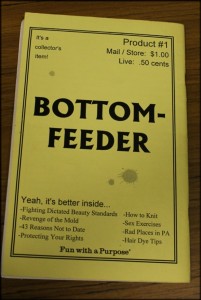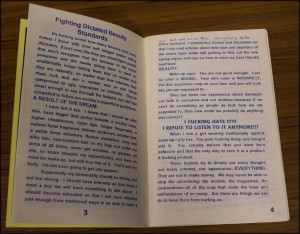Every month, our volunteer Ari Silvera tells us about the world of underground publishing, from the Library’s zine archive, to interviewing active zine makers and beyond!
Hello and welcome to the very first Monthly Zinester column! I’m Ari Silvera, and I have been passionate about zines for the better part of a decade now, and I’m grateful to have the opportunity to highlight some of the gems hiding in the GWL zine archive. But before we move to the main event, you’re probably wondering: what are zines, and why are they so important that they merit archival space in the Women’s Library?
What’s a zine?
Well, a zine, generally speaking, is a small magazine, published by a small or independent press, or by the author themselves. The term “zine” was used as early as 1946, when it became popularised with the growing science fiction fanzine movement. Science fiction fans would write to each other through the letter pages of popular publications, which inspired them to create their own publications to exchange ideas. Thus the fanzine was born.
A further evolution of the zine came in the 1970s, when mass political movements, new music subcultures and the popularisation of the photocopier co-incide across western Europe and in the United States. It was with the punk movement, which encouraged creativity, criticism and a celebration of the marginalised, that zines as we know them today flourished.
The personal zine, or perzine, with writings about the author’s own life, had emerged in the sci-fi zine era but it completely exploded in popularity at this time. In the burgeoning punk movement, we have the phenomenon of music fanzines as the main venue for discussion and dissemination of ideas. The fact that zine printing and publishing was not filtered through the mass media allowed it to give a voice to marginalised populations: people of colour, women, and LGBTQ people of all stripes. This probably reached its peak in the 1990s, before the Internet was as commonplace as it is today, with the riot grrrl movement, which sought to challenge the inherent sexism and other oppressions within punk and DIY subcultures.
And so, we arrive at the present day, when zines are still made and exchanged, either online through projects such as the Queer Zine Archive Project, Zinelibrary.info ; or Zine fairs, music gigs, and social centres. Many zinesters are eager to offer their work both online and in print form. Others argue it is the material, palpable nature of a zine and its exchange in person with another human being that is at the root of its purpose as a personal way to communicate with others. While many have prognosticated the ‘death of the zine’ due to the proliferation of the internet, this form of do-it-yourself publishing does, indeed, live on, as well as being an intrinsic part of the cultural history of the past hundred years.
ZINE REVIEW: BOTTOM-FEEDER #1 BY ROBYN STEPHENS
Each month, I’ll be reviewing a zine from the Glasgow Women’s Library zine archive. Starting up, we have BOTTOM-FEEDER #1, by Robyn Stephens.
B-F #1 was produced in Pennsylvania, USA, probably written during the summer of ’96 and, as far as my research shows, published sometime in the next couple of years. B-F #1 is a ‘perzine’, and as this term implies, it is packed with Robyn’s thoughts on life, from dating, to beauty standards and beyond. In the tradition of riot grrrl zines, the author challenges us to question given knowledge in terms of sex and gender, as well as including tips about protecting one’s rights, hair dying, and cool places the author likes in Pennsylvania.
The overall tone can sometimes be a bit preachy, but B-F #1 is a perfect example of the very first zines I came in touch with in the mid-2000s. Many perzines follow the feminist tradition of connecting the personal with the political, a tradition that both enables the creator to feel connected to the wider world, as well as making them approachable to others. With all her questioning, with all her doubts and her anger, Robyn also tells us to care about one another, that women need to support each other in a world that often tries to make us compete amongst women. She tells us of scams she’s run, bad dates and relationships, the fun of knitting as well as a drunken rant from her 21st birthday and her feelings of loneliness. Through her zine, we learn of who Robyn was, and what she was doing in the late 90s, than a photograph of her from that time period could.
That’s all for this month, see you in August for the Monthly Zinester #2 – Navigating the Zine Archive!
Ari Silvera is a migrant trans woman from Argentina currently residing in Glasgow, with a background in grassroots activism and writing on issues regarding migration, trans/queer life and politics, and anti-capitalist perspectives. She loves zines, coffee and playing Minecraft.



Comments are closed.